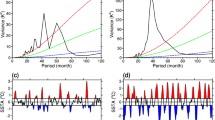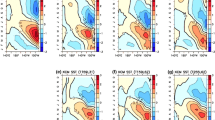Abstract
The focus is on sensitivity studies to identify factors that increase the skill of the ECHAM4 atmosphere general circulation model (GCM) in representing the intraseasonal oscillation (ISO). The ISO mode is dominated by an eastward propagating oscillation during boreal winter, also known as the Madden-Julian oscillation. A previous study compared observations and reanalysis data to uncoupled and coupled versions of the ECHAM4 GCM. The sensitivity experiments in the present study use those results to assess the importance of the following mechanisms for the simulation of the ISO. First, the vertical resolution is increased to indicate the effect of improved representation of the tropospheric stratification. Second, the horizontal resolution is increased to investigate the importance of the ratio of vertical and horizontal resolution. Third, the effects of the land-sea distribution are studied in an experiment with land points associated with the maritime continent replaced by sea points. Fourth, the ECHAM4 GCM is forced by a T42 version of the observed optimum interpolated SST (OISST) dataset as used in the ECMWF reanalysis to study the influence of the SST as a boundary condition. In addition to integrations with monthly mean SSTs, also an experiment with weekly mean SSTs is examined. The increased vertical resolution slightly slows down the propagation speed of the simulated ISO. Increasing the horizontal resolution from T42 to T106 results in a very noisy and therefore poorer simulation of the ISO. It is suggested that this is due to an inappropriate ratio of vertical and horizontal resolution. Replacing the land points associated with the maritime continent with sea points leads to a more realistic representation of convection over the maritime continent than in the standard model. A consequence is a reduction of the erroneous eastward shift of the simulated ISO activity, although the phase speed of the ISO is simultaneously increased. ECHAM4 forced by an OISST dataset interpolated to the model’s T42 grid leads to the strongest improvements, since the annual mean AMIP SST averaged over the maritime continent region is 0.14 K warmer than the OISST, and individual grid points can be more than 0.5 K warmer. The reason is that the AMIP SST uses only measurements over water for grid points that are partly covered by land, whereas the OISST also blends these measurements with measurements over the land portions. ECHAM4 forced by the interpolated OISST, which is in the mean only 0.04 K colder over the maritime continent than the OISST, produces a reasonable ISO with a mean period of 40 days for a forcing with monthly mean SSTs and 48 days for a forcing with weekly mean SSTs. These results illustrate the strong influence of the details of the prescribed SST on the simulation of the ISO.














Similar content being viewed by others
References
Central Intelligence Agency (2001) The world factbook 2001. Washington D.C., http://www.cia.gov/cia/publications/factbook/
Fox-Rabinovitz MS, Lindzen RS (1993) Numerical experiments on consistent horizontal and vertical resolution for atmospheric models and observing systems. Mon Weather Rev 121: 264–271
Gallagher F, von Storch H, Schnur R, Hannoschoeck G (1991) The POP manual. Techn Rep 1, Deutsches Klimarechenzentrum, Hamburg, Germany, pp 66
Gualdi S, Navarra A, Tinarelli G (1999) The interannual variability of the Madden-Julian oscillation in an ensemble of GCM simulations. Clim Dyn 15: 643–658
Gualdi S, Navarra A, von Storch H (1997) Tropical intraseasonal oscillation appearing in operational analysis and in a family of general circulation models. J Atmos Sci 54: 1185–1202
Hendon HH, Salby ML (1994) The life cycle of the Madden-Julian oscillation. J Atmos Sci 51: 2225–2237
Inness PM, Slingo JM, Woolnough SJ, Neale RB, Pope VD (2001) Organization of tropical convection in a GCM with varying vertical resolution; implications for the simulation of the Madden-Julian oscillation. Clim Dyn 17: 777–793
Johnson RH, Rickenbach TM, Rutledge SA, Ciesielski PE, Schubert WH (1999) Trimodal characteristics of tropical convection. J Clim 12: 2397–2418
Kemball-Cook SR, Wang B, Fu X (2002) Simulation of the intraseasonal oscillation in the ECHAM-4 Model: the impact of coupling with an ocean model. J Atmos Sci 59: 1433–1453
Land C, Ponater M, Sausen R, Roeckner E (1999) The ECHAM4.L39(DLR) atmosphere GCM: technical description and model climatology. DLR-Forschungsbericht 31, Institut fur Physik der Atmosphare des DLR, Oberpfaffenhofen, Germany, pp. 45
Lau KM, Wu HT, Yang S (1998) Hydrologic processes associated with the first transition of the Asian summer monsoon: a pilot satellite study. Bull Am Meteorol Soc 79: 1871–1882
Liess S, Bengtsson L, Arpe K (2004) The intraseasonal oscillation in ECHAM4. Part I: coupled to a comprehensive ocean model. Clim Dyn (DOI 10.1007/s00382-004-0406-0)
Madden RA, Julian PR (1971) Detection of a 40-50 day oscillation in the zonal wind in the tropical Pacific. J Atmos Sci 28: 702–708
Madden RA, Julian PR (1972) Description of global-scale circulation cells in the tropics with a 40-50 day period. J Atmos Sci 29: 1109–1123
Madden RA, Julian PR (1994) Observations of the 40-50-day tropical oscillation - a review. Mon Weather Rev 122: 814–837
Maloney ED, Hartmann DL (2001) The sensitivity of intraseasonal variability in the NCAR CCM3 to changes in convective parametrization. J Clim 14: 2015–2034
Neale R, Slingo J (2003) The maritime continent and its role in the global climate: a GCM study. J Clim 16: 834–848
Nordeng TE (1994) Extended versions of the convective parametrization scheme at ECMWF and their impact on the mean and transient activity of the model in the tropics. Tech. Memo. 206, ECMWF Research Department, European Centre for Medium-Range Weather Forecasts, Reading, UK, pp. 41
Reynolds RW, Smith TM (1994) Improved global sea surface temperature analysis using optimum interpolation. J Clim 7: 929–948
Roeckner E, Arpe K, Bengtsson L, Christoph M, Claussen M, Dümenil L, Esch M, Giorgetta M, Schlese U, Schulzweida U (1996) The atmospheric general circulation model ECHAM4: Model description and simulation of present-day climate. Report 218, Max-Planck-Institut für Meteorologie, Hamburg, Germany, pp. 90
Salby ML, Garcia RR, Hendon HH (1994) Planetary-scale circulations in the presence of climatological and wave-induced heating. J Atmos Sci 51: 2344–2367
Schubert W, Ciesielski PE, Lu C, Johnson RH (1995) Dynamical adjustment of the trade wind inversion layer. J Atmos Sci 52: 2941–2952
Slingo J, Blackburn M, Betts A, Brugge R, Hodges K, Hoskins B, Miller M, Steenman-Clark L, Thuburn J (1994) Mean climate and transience in the tropics of the UGAMP GCM: sensitivity to convective parametrization. Q J R Meteorol Soc 120: 881–922
Slingo JM, Sperber KR, Boyle JS, Ceron JP, Dix M, Dugas B, Ebisuzaki W, Fyfe J, Gregory D, Gueremy JF, Hack J, Harzallah A, Inness P, Kitoh A, Lau WKM, McAvaney B, Madden R, Matthews A, Palmer TN, Park CK, Randall D, Renno N (1996) Intraseasonal oscillations in 15 atmospheric general circulation models: results from an AMIP diagnostic subproject. Clim Dyn 12: 325–357
Sperber KR, Slingo JM, Inness PM, Lau WKM (1997) On the maintenance and initiation of the intraseasonal oscillation in the NCEP/NCAR reanalysis and the GLA and UKMO AMIP simulations. Clim Dyn 13: 769–795
Sud YC, Walker GK (1999) Microphysics of clouds with the relaxed Arakawa-Schubert scheme (McRAS). Part I: design and evaluation with GATE phase III data. J Atmos Sci 56: 3196–3220
Sui CH, Lau KM (1989) Origin of low-frequency (intraseasonal) oscillations in the tropical atmosphere. Part. II: structure and propagation of mobile wave-CISK modes and their modification by lower boundary forcings. J Atmos Sci 46: 37–56
Tompkins AM, Emanuel KA (2000) The vertical-resolution sensitivity of simulated equilibrium tropical temperature and water-vapor profiles. Q J R Meteorol Soc 126: 1219–1238
von Storch H, Zwiers FW (1999) Statistical analysis in climate research. Cambridge University Press, Cambridge, UK, pp. 550
Waliser DE, Jin K, Kang IS, Stern WF, Schubert SD, Wu M, Lau KM, Lee MI, Krishnamurthy V, Kitoh A, Meehl GA, Galin VY, Satyan V, Mandke SK, Wu G, Liu Y, Park CK (2003) AGCM simulations of intraseasonal variability associated with the Asian summer monsoon. Clim Dyn 21: 423–446
Waliser DE, Lau KM, Kim JH (1999) The influence of coupled sea surface temperatures on the Madden-Julian oscillation: a model perturbation experiment. J Atmos Sci 56: 333–358
Wang B, Rui H (1990) Dynamics of the coupled moist Kelvin-Rossby wave on an equatorial β-plane. J Atmos Sci 47: 397–413
Zhang C, Anderson SP (2003) Sensitivity of intraseasonal perturbations in SST to the structure of the MJO. J Atmos Sci 60: 2196–2207
Acknowledgements
The authors would like to thank Christine Land for the ECHAM4T30L39 version and Ingo Kirchner for the provision of the GCM interface for weekly SSTs. Silvio Gualdi, Pete M. Inness, Duane E. Waliser, an anonymous reviewer and the staff at the Max-Planck Institute for Meteorology and the State University of New York at Stony Brook provided helpful comments and discussions. This study was partially supported by NOAA under grant NA16GP2021.
Author information
Authors and Affiliations
Corresponding author
Rights and permissions
About this article
Cite this article
Liess, S., Bengtsson, L. The intraseasonal oscillation in ECHAM4 Part II: sensitivity studies. Climate Dynamics 22, 671–688 (2004). https://doi.org/10.1007/s00382-004-0407-z
Received:
Accepted:
Published:
Issue Date:
DOI: https://doi.org/10.1007/s00382-004-0407-z




